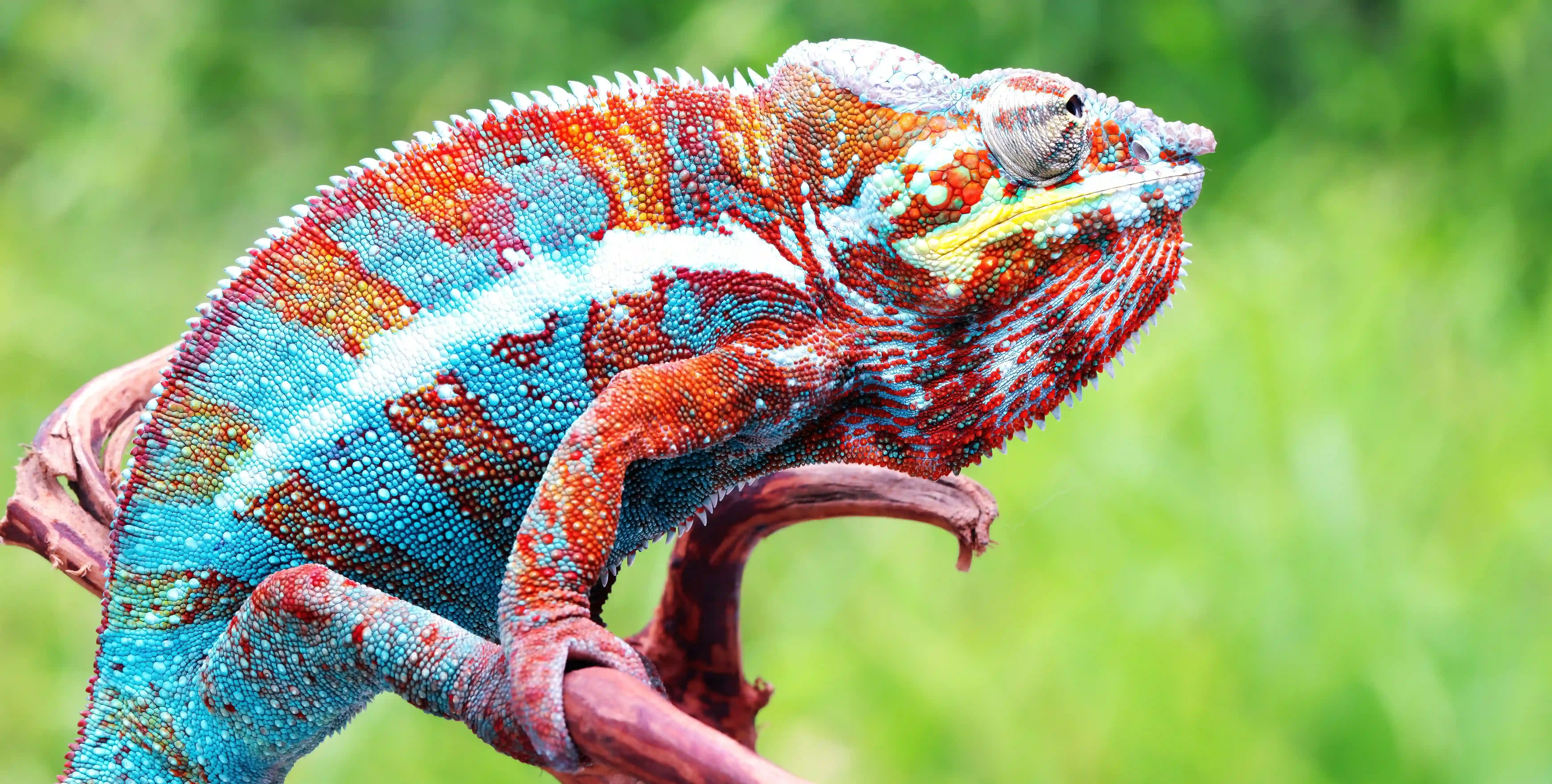Blue humans?

Why does skin colour change in chameleons but not in humans?
Chameleons are well known for changing colours constantly, a feat that not many mammals can achieve. However, many other species from the other classes in the Chordata phylum can. This ability also extends to some organisms in other phyla. For example, many species of crustaceans and arthropods can change colour rapidly. An important point to note is that the change being discussed is an instantaneous one that might be helpful for a chameleon to escape from predators in a dangerous situation.
The colour of the skin is determined by specialised cells that are called Chromatophores. The term Chromatophores is an umbrella term that contains many different types of cells, all of which have a different effect on skin colour. The types of chromatophores that are most important are Melanophores and Iridophores. Other Chromatophores are more likely to be used for a sustained colour or passive colour change. The cells often work together to form the layers of cells that form the skin of the chameleon. The focus of this article will be Iridophores and Melanophores as they are the only dynamic Chromatophores.
The structure of the skin has the epidermis and the basal lamella as the outermost layers. The epidermis is a few stacks of compound stratified cells and the basal lamella is a matrix formed by the epidermis. Below this is the unit of Chromatophore. Xanthophores (another type of chromatophore) are found as a layer nearest to the base lamella. Below it, is a layer of Iridophores and below and between the gaps is a layer of Melanophores.
Before exploring the affect that these layers have on colour, it is important to understand that colour is observed as a result of light and that light is a type of electromagnetic radiation. This radiation can have different wavelengths. At a specific range of wavelengths, the waves are visible to humans as light and have a colour depending on which wavelengths enter the eye. Objects can either absorb or reflect light rays. An object that absorbs all wavelengths in the visible spectrum except red will appear red and an object that absorbs all wavelengths in the visible spectrum except those of blue will appear blue. The light rays from the sun cover all wavelengths of the spectrum.
Now, Iridophores are unable to reflect the longer wavelengths of light, so the longer wavelengths pass through the iridophore layer to the Melanophore layer. The shorter wavelengths, however, can be reflected at the top of the Iridophore layer. The chameleon can change the formation of the Iridophore layer which helps to reflect certain wavelengths of light. The layer is made up of mini plates, which can laterally disperse by sliding across, or gather in the same way. This affects the relative reflectance or the brightness of any rays that are reflected, which in turn, affect the perceived colour by the cones in the eyes.
The Melanophores can reflect the longer wavelengths of light that pass through the Iridophore layer. Similar to how chloroplasts contain the green pigment chlorophyll, Melanophores contain a pigment called Melanin. Melanin has many different sub-species which are the reason why the colour of the melanophores can change. The Melanin subspecies will have their own colour and the wavelengths that the melanophores will reflect and those which will be absorbed depends on which melanin sub-species are present and their relative concentrations. However, the predominant colours will range from yellow to red. Helpfully, Melanophores are able to produce their own melanin. This allows for faster colour change.
How does this system relate to the one in humans? Humans have their own melanophores but as you may or may not know, there are not many colour changing humans. This is since humans only have a maximum of 3 types of melanin that are Eumelanin, Neuromelanin and Pheomelanin. The first 2 are predominantly dark brown to black in colour and Pheomelanin can be between yellow and red. Naturally, it makes sense that Pheomelanin would be found in lips or in blonde – ginger hair. This would explain why sometimes ginger hair can fade into blonde hair and vice versa. However, Eumelanin is most found in the rest of the human body. Skin colour will be dependent on the concentration of Eumelanin in the Melanophores. More Eumelanin means a darker skin tone and vice versa. Some studies into the reason for different skin colours has shown that Eumelanin is responsible for acting as a protection against UV radiation from the sun. This data would imply that places with more UV radiation and therefore, more sunlight would have people with darker skin. This backs up general trends in skin colour around the world.
So, can people properly change skin colour, or not? Using logical reasoning, the only Melanin that human skin Melanophores can produce is Eumelanin and humans do not have Iridophores, so the answer to the question must be no; unfortunately, blue humans are not about to start roaming the earth.
Despite this, surely humans could change the colour of their skin from light to dark. The reason why this cannot happen is because change in base melanin concentration cannot be decreased naturally without a mutation in the DNA. However, the melanin concentration can increase temporarily and then decrease slowly until it reaches the original skin colour. This is a result of spending too much time in the sun or more commonly known as tanning. Tanning occurs to protect the body from UV light as mentioned above. However, after a while, skin exfoliation occurs, causing the excess melanin to be removed as pigmented cells are sloughed off.
To conclude, I will summarise the key points. Chameleons can change colour dynamically through melanophores and iridophores, both of which are chromatophores. Iridophores change colour by changing their structure but melanophores cause colour change using a pigment called melanin. Iridophores can reflect shorter wavelengths of light like blue and green. However, Melanophores can reflect longer wavelengths of light like yellow and red. Humans only have melanophores and can only reflect longer wavelengths of light. Skin tone is determined by the concentration of melanin which is predetermined in the individual’s genetic code. The concentration of melanin can be temporarily increased as a defensive mechanism to UV light but will be reduced naturally after skin exfoliation. Generally, human skin cannot change colour and most colour changes will be a result of a disease or mutation.


